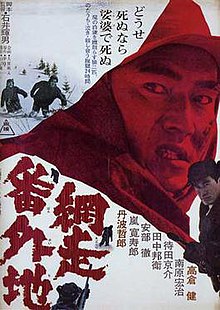.mw-parser-output .hidden-begin{box-sizing:border-box;width:100%;padding:5px;border:none;font-size:95%}.mw-parser-output .hidden-title{font-weight:bold;line-height:1.6;text-align:left}.mw-parser-output .hidden-content{text-align:left}@media all and (max-width:500px){.mw-parser-output .hidden-begin{width:auto!important;clear:none!important;float:none!important))You can help expand this article with text translated from
the corresponding article in Japanese. (February 2024) Click [show] for important translation instructions.
View a machine-translated version of the Japanese article.
Machine translation, like
DeepL or
Google Translate, is a useful starting point for translations, but translators must revise errors as necessary and confirm that the translation is accurate, rather than simply copy-pasting machine-translated text into the English Wikipedia.
Consider
adding a topic to this template: there are already 3,780 articles in the
main category, and specifying|topic= will aid in categorization.
Do not translate text that appears unreliable or low-quality. If possible, verify the text with references provided in the foreign-language article.
You must provide
copyright attribution in the
edit summary accompanying your translation by providing an
interlanguage link to the source of your translation. A model attribution edit summary is Content in this edit is translated from the existing Japanese Wikipedia article at [[:ja:網走番外地 (東映)]]; see its history for attribution.
You should also add the template ((Translated|ja|網走番外地 (東映))) to the
talk page.
For more guidance, see
Wikipedia:Translation.
1965 Japanese film
| Abashiri Prison |
|---|
 Theatrical release poster |
| Directed by | Teruo Ishii[1] |
|---|
| Written by | Teruo Ishii |
|---|
| Based on | Abashiri Bangaichi
by Hajime Itō |
|---|
| Starring | Ken Takakura |
|---|
| Cinematography | Yoshikazu Yamasawa |
|---|
| Music by | Masao Yagi |
|---|
| Distributed by | Toei Company |
|---|
Release date |
- April 18, 1965 (1965-04-18)
|
|---|
Running time | 92 minutes |
|---|
| Country | Japan |
|---|
| Language | Japanese |
|---|
Abashiri Prison (Japanese: 網走番外地, Hepburn: Abashiri Bangaichi), also known as A Man from Abashiri Prison,[2] is a 1965 Japanese film written and directed by Teruo Ishii. Based on the 1956 novel of the same name by Hajime Itō, Ishii wrote the script as a remake of the 1958 American film The Defiant Ones. The film is the first entry in Toei Company's Abashiri Prison series, which stars Ken Takakura. Highly successful, it was the first hit in the yakuza film genre.[3] Abashiri Prison made Takakura a star and was followed by 17 sequels.[2]
Synopsis
In Hokkaido's Abashiri Prison, Shinichi Tachibana, model prisoner with six months remaining in his sentence is handcuffed to Gonda, a hardened criminal. When Gonda and other inmates escape from the prison, Tachibana must go along.[2][4]
Production
Hajime Itō wrote the 1956 novel Abashiri Bangaichi based on his experience incarcerated at the real Abashiri Prison in the early 1950s. The book was previously adapted into a film by Nikkatsu in 1959. Director Teruo Ishii modeled his version on the 1958 American film The Defiant Ones, which he had wanted to make a Japanese version of ever since he first saw the film.[5] When Ishii was offered to adapt Abashiri Bangaichi, he did not want to do it after reading the novel; "the story was too cheesy—it was just a melodrama."[5] However, Toei Company agreed to allow him to change the story and approved of remaking The Defiant Ones.[5]
Ishii said the script was written quickly, but was done without any location scouting, which caused problems when they actually got to Hokkaido.[5] It took a whole month just to find a railroad to shoot the handcar escape scene.[5] They finally found one in Shintoku, but the small town had no inns, and the crew had to stay at a dormitory in the mountains.[5] The winter climate also made things difficult, as the engines in the crew's cars would freeze overnight.[5]
Abashiri Prison is known for its titular theme song sung by its lead, Ken Takakura. A traditional folk song sung by prisoners, Ishii had first heard it played by former yakuza in a television documentary.[5] He quickly grabbed a tape recorder and recorded it, and then had the TV station identify it for him.[5] He first used the song in his film Kaoyaku, which was released earlier in 1965, where it was also sung by Takakura.[5]
Sequels
Toei produced 17 sequels in the Abashiri Prison film series between 1965 and 1972, all starring Ken Takakura and scored by Masao Yagi, and with Ishii returning to direct the first nine.[2] The final eight installments were released under the title New Abashiri Prison, with Masahiro Makino directing the first two, Kiyoshi Saeki the third, and Yasuo Furuhata handling the last five.
Mark Schilling writes that Japanese critics and fans widely regard the third installment, Abashiri Prison Bōkyō-hen (1965), as the best in the franchise.[2] Ishii chose the first film as his personal favorite as he said that is the one he worked the hardest on. After that, he said the studio forced him to make them one after the other and it became "routine".[5] When asked why the third film was set in Kyushu, Ishii explained that when he told Toei he could not make another installment in the series yet because it was not winter, they remarked that it did not matter and he could shoot anything as long as the theme song was on the soundtrack.[5]
